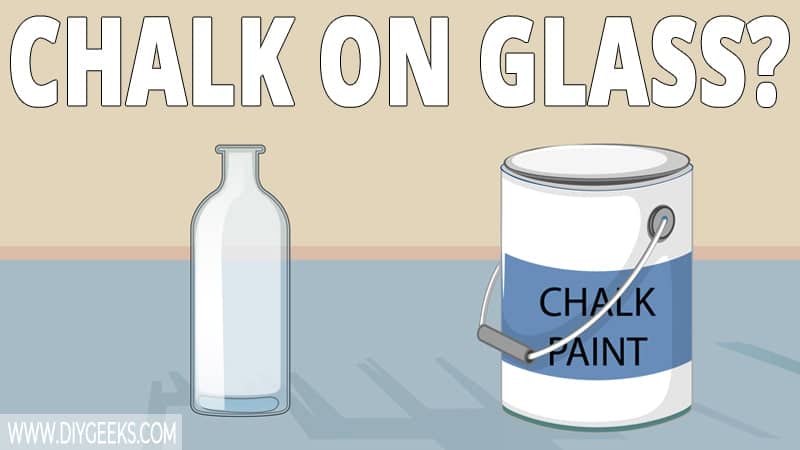Chalk paint is water-based while glass is a non-porous material that doesn’t accept paint well. You can apply chalk paint on glass surfaces if the surface is clean and not painted (or sealed).
To apply chalk paint on glass surfaces, clean the surface with rubbing alcohol, wet sand the glass, and apply the paint.
Does Chalk Paint Adhere to Glass Surfaces?
Chalk paint does adhere to glass surfaces initially, but the paint will peel off if the surface isn’t prepped properly. Before applying chalk paint, you must clean, wet sand, and prime the glass surface.
Cleaning removes the dust, dirt, and debris from the surface, wet sanding with fine-grit sandpaper creates tiny holes (pores) that the paint or primer can penetrate, and priming covers the slick surface of the glass and provides a layer for paint to stick to.
If the glass is painted or sealed, you must remove the existing finish before applying chalk paint.
Related Read: Can You Use Chalk Paint on Plastic?
How To Apply Chalk Paint Over Glass?
To apply chalk paint over glass, do the following things.
- Clean the Surface with Rubbing Alcohol.
- Wet Sand the Glass Surface.
- Apply Chalk Paint.
- Seal the Finish.
The tools you need for this project are listed below.
- Rubbing or Isopropyl Alcohol.
- Paper Towel
- A Sealer Or Clear Topcoat
- A brush (preferably a small brush)
- Chalk Paint
- Water
- Fine-grit sandpaper Or Sanding Block
1. Clean the Surface with Rubbing Alcohol
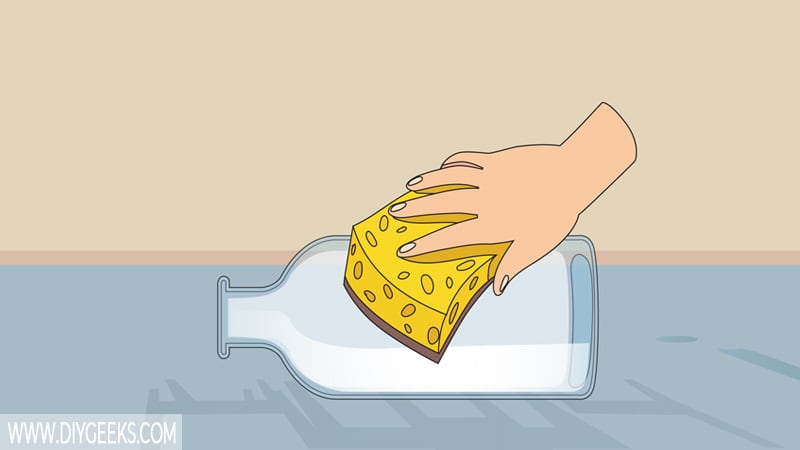
Clean the glass surface with rubbing alcohol to remove dirt, dust, debris, and grease that can prevent paint adhesion. Rubbing alcohol is a considered mild solvent and can be used as a cleaning agent.
To clean the glass surface before painting, do the following things.
- Pour rubbing alcohol or degreaser into a clean rag.
- Use the dampened rag to wipe the surface.
- Wait a few minutes (5-10).
- Use warm soapy water to remove the rubbing alcohol residue.
You must remove the rubbing alcohol residue or the paint won’t adhere. Rubbing alcohol is a natural paint remover and will prevent chalk paint from adhering.
2. Wet Sand (Optional)
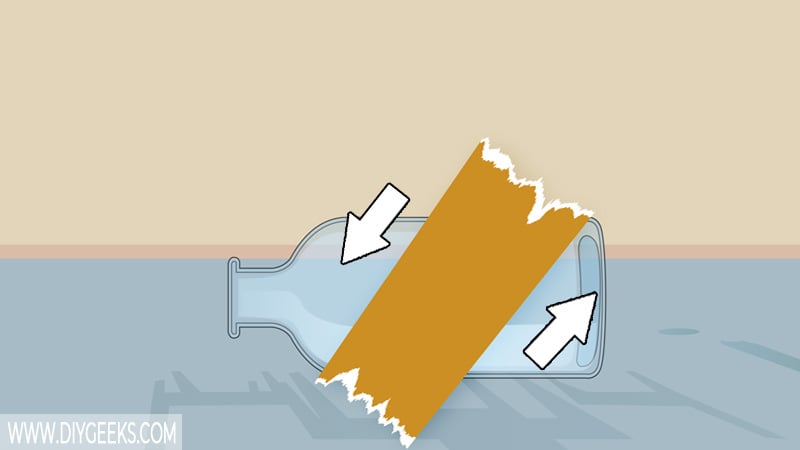
Wet sand the glass surface to remove imperfections and bumps, and create tiny holes (or pores) that paint can penetrate to.
To wet sand glass surfaces, use extra fine-grit sandpaper (440-grit). Extra fine-grit sandpaper won’t damage the surface or scratch it, instead, it will smooth it out for paint.
Don’t use coarse or medium-grit sandpaper as it will scratch and damage the glass surface.
Clean the glass surface with warm water after sanding it.
3. Apply Chalk Paint
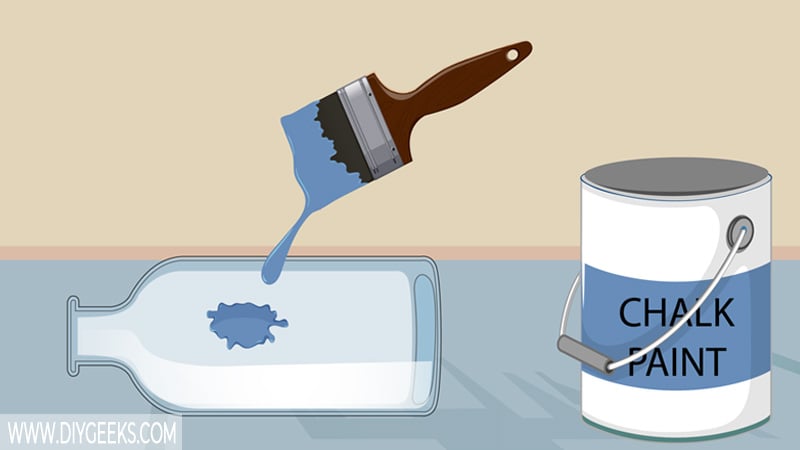
To apply chalk paint, do the following things.
- Apply 3-4 coats of chalk paint using a paint sprayer or brush.
- Wait until one coat dries before applying the next one. Chalk paint takes 30 minutes to dry between coats.
- Optionally, sand between coats.
A sprayer provides better finish quality and paint adhesion. A brush allows you to apply thin coats without wastage.
4. Seal the Finish.
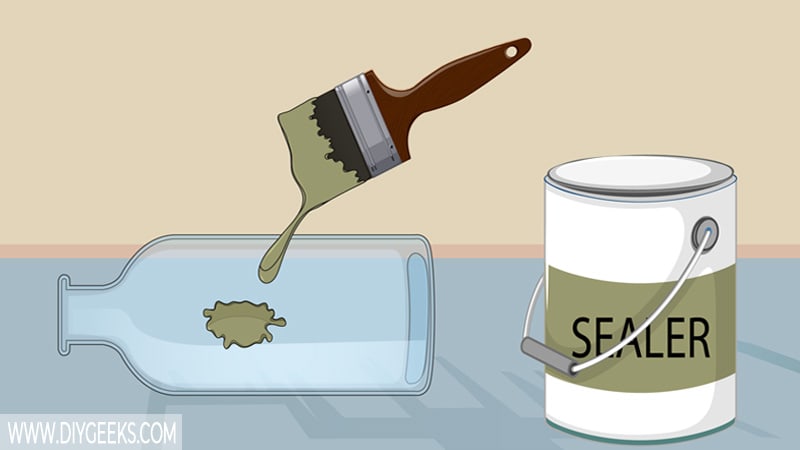
Seal the chalk paint finish if the glass surface is placed outdoors. Chalk paint isn’t durable enough to protect outdoor surfaces from weather elements, such as rainfall.
To seal chalk paint, apply 2-3 coats of wax, lacquer, or polyurethane. The sealer will produce a glossy moisture-resistant layer over the paint and protect it from water, moisture, scratches, handling, and weather elements.
You don’t need to seal chalk paint for indoor surfaces as the finish won’t be exposed to constant water, moisture, or weather elements.
Chalk paint is water-based and doesn’t have protective additives on its formula that protect the surface.
How Long Does Chalk Paint Take to Dry on Glass?
Chalk paint takes around 30 minutes to dry between coats and around 24 hours to cure (fully dry) on plastic surfaces. The exact dry time depends on the room temperature, humidity levels, thickness and number of paint coats.
Chalk paint dries faster because it’s a water-based paint that uses water as its paint solvent. Since water evaporates fast from the coating, the paint gets dry and rigid faster than most paints.
Glass is non-porous so paint won’t penetrate its surface deep and will start to dry immediately. Chalk paint will dry faster on glass than on other surfaces as the paint solvent starts to evaporate immediately after you apply it.
Related Read: How To Paint Over Chalk Paint?
Can You Apply Chalk Paint on a Mirror?
You can apply chalk paint to a mirror surface because the paint has impressive bonding qualities.
To apply chalk paint on mirror surfaces, do the following things.
- Use a synthetic or natural brush.
- Apply 2-3 light coats of chalk paint.
- Don’t apply too much force while applying it.
- Allow the finish to dry before using the mirror.
Why Won’t Chalk Paint Stick on a Glass Surface?
Chalk paint won’t stick on a glass surface if the surface is dirty or already painted or sealed with another paint finish. Dirt, paint or sealed finish prevents chalk paint from adhering as the paint can’t penetrate the surface.
For instance, oil-based paints or sealers have a glossy finish that repels chalk paint and prevents it from penetrating the surface.
If the glass surface is dirty, clean it with a mild solvent, such as rubbing alcohol, to remove the dirt or dust. If the glass surface is already painted or sealed, remove the existing finish with a paint-stripping solvent before applying the chalk paint.
Why Won’t Chalk Paint Dry on Glass Surfaces?
Chalk paint won’t dry on glass surfaces if the temperature is lower than 50°F (10°C), the humidity levels are higher than 50%, or if the surface is dirty or already painted.
To fix a sticky chalk paint finish on glass surfaces, do the following things.
- Remove excess chalk paint.
- Wait until the remaining paint dries.
- Sand off the bumps in the finish.
- Apply a new coat.
If the finish stays tacky for several days, do the following things.
- Damp a clean rag into rubbing alcohol.
- Use the dampened rag to clean/remove the tacky finish.
- Re-apply it.
